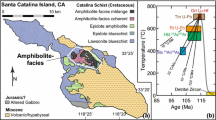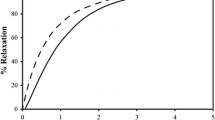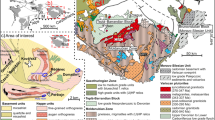Summary
The efficacy of ion exchange in petrological systems, for example the Fe-Mg exchange between garnet and biotite, is a function of grainsize, temperature, rates of temperature change and diffusion parameters. The combination of these variables determines the final zoning profile of minerals. Therefore, zoning profiles may be used to derive one of these variables if the others are known. For example, a mineral grain that experienced a short thermal event may still preserve a zoning profile characteristic of the heating path. In contrast, if that grain experienced a long thermal event it may develop a zoning profile typical of the cooling path. Conversely, for the same temperature-time cycle, large grains may not completely equilibrate at the metamorphic peak, and in smaller grains any previous record may have been erased. This is commonly observed in natural rocks where different grains within one thin section preserve often qualitatively different zoning profiles. Thus, a critical grainsize,l crit, may exist that separates grains with qualitatively different zoning profiles so that grains of sizel > l crit still retain zoning information about the heating path and grains of sizel <l crit contain only information about the cooling path. If the critical grainsize can be measured and an independent estimate for the peak metamorphic temperature exists, the duration of the thermal event may, in principle, be estimated.
The applicability of this method to natural garnets is hampered by a range of uncertainties. However, a parameterisation of the critical grain size may be used to illustrate the relative importance of grain size, temperature and event duration to the equilibration of minerals. In this paper, the critical grainsize is parameterized for various temperature-time cycles and its dependence on diffusion parameters is discussed. It is shown that, for Barrovian conditions,l crit between 0.1 and 1 mm separates garnets retaining prograde information from garnets retaining cooling path information. For illustration, we compare the results with the critical grainsize of garnets from two metamorphic terranes, the Prydz Bay region (Antarctica) and the Koralm complex (Eastern Alps). Despite the large range of uncertainties attached to the method, it is shown that the critical grainsize of garnets in both terranes is consistent with a very short duration of the last thermal event that affected the two regions.
Zusammenfassung
Zonierungsprofile von Paragenesen im Ionenaustausch, zum Beispiel das Fe-Mg Austauschsgleichgewicht zwischen Granat und Biotit, sind eine Funktion von (i) Korngröße, (ii) Temperatur, (iii) Kühl- und Heizgeschwindigkeit sowie (iv) den Diffusionskonstanen. Es sollte daher möglich sein, Zonierungsprofile dazu zu verwenden, einen dieser Parameter zu bestimmen, wenn die anderen bekannt sind. Zonierungsprofile von Kristallen die ein kurzes thermisches Ereignis erfahren haben, mögen daher “prograde” Information beinhalten, wogegen derselbe Kristall ein “retrogrades” Profil aufweisen mag, wenn er einem langlebigen thermischen Ereignis unterlag (“prograd” und “retrograd” ist hier als: “bei ansteigender Temperatur” und “bei abfallender Temperatur” definiert). In Kristallen die dem gleichen Temperatur-Zeitpfad unterworfen waren, könnten kleine Körner nur die Kühlgeschichte dokumentieren, wogegen große noch Zonierungsinformation vom Heizpfad aufweisen. In natürlichen Gesteinen wird das oft dadurch beobachtet, daß verschiedene Körner auseinem Dünnschliff qualitativ verschiedene Zonierungsprofile aufweisen. Es ist daher möglich eine kritische Korngöße,l crit, zu definieren, die Korngrößen mit qualitativ verschiedenen Zonierungsprofilen voneinander trennt. Körner mit einem Durchmesserl > l crit haben, zumindest teilweise, noch “prograde” Profile, wogegen Körner mitl <l crit nur “retrograde” Information dokumentieren. Wenn man diese kritische Korngröße messen kann, sollte sie dazu benutzt werden können, etwas über die Dauer des thermischen Ereignisses auszusagen.
Die Anwendbarkeit dieser Methode ist durch eine Reihe von Fehlern limitiert. Nichtsdestotrotz, ist eine Parameterisierung der kritischen Korngröße nützlich um die relative Wichtigkeit von Korngröße, Temperatur und Zeit, für die Entwicklung von Zonierungsprofilen, zu illustrieren. Unser Modell kann dazu benutzt werden, um die Größenordnung von Granaten abzuschätzen, die noch “prograde” Information dokumentieren können. Die Abhängigkeit der kritischen Korngröße von Diffusionsparametern und der Form des Temperatur-Zeit Pfades wird ebenfalls diskutiert. Es wird gezeigt, daß für Metamorphose in der mittleren Grünschiefer und Amphibolit fazies,l crit zwischen 0.1 and 1 mm “prograd” zonierte von “retrograd” zonierten Granaten trennt. Um das Modell zu illustrieren, werden die Ergebnisse auf die Prydz Bay Region (Antarktis) und den Koralm Komplex (Ostalpen) angewendet. Trotz der großen Fehlergrenzen der Methode glauben wir zeigen zu können, daß die kritische Korngröße beider Terrains andeutet, daß das letzte thermische Ereignis in beiden Gebieten kurzlebig war.
Similar content being viewed by others
References
Bohlen SR (1987) Pressure temperature time paths and a tectonic model for the evolution of granulites. J Geol 95: 617–632
Chakraborty S, Ganguly J (1990) Compositional zoning and cation diffusion in garnets. In: Ganguly J (ed) Diffusion, atomic ordering and mass transport, pp 121–171
Crank J (1975) The mathematics of diffusion. Oxford Science Publications. Clarendon Press, Oxford, 414 pp
Cygan RT, Lasaga AC (1985) Self-diffusion of magnesium in garnet at 750 °C to 900 °C. Am J Sci 285: 328–350
Ehlers K, Powell R (1994) An empirical modification of Dodson's equation for closure temperature in binary systems. Geochim Cosmochim Acta 58: 241–248
Ehlers K, Powell R, Stüwe K (1994a) The determination of cooling histories from garnet-biotite equilibria. Am Min 79: 737–744
Ehlers K, Stüwe K, Powell R, Sandiford M, Frank W (1994b) Thermometrically-inferred cooling rates from the Plattengneis, Koralm Region-Eastern Alps. Earth Planet Sci Lett 125: 307–321
Elphick SC, Ganguly J, Loomis TP (1985) Experimental determination of cation diffusivities in aluminosilicate garnets 1. Experimental methods and interdiffusion data. Contrib Mineral Petrol 90: 36–44
Ferry JM, Spear FS (1978) Experimental calibration of the partitioning of Fe and Mg between biotite and garnet. Contrib Mineral Petrol 66: 113–117
Freer R (1979) An experimental measurement of cation diffusion in almandine garnet. Nature 280: 220–222
Freer R (1981) Diffusion in silicate minerals and glasses: a data digest and guide to the literature. Contrib Mineral Petrol 76: 440–454
Harley SL (1989) The origin of granulites: a metamorphic perspective. Geol Mag 126: 215–247
Lasaga AC (1983) Geospeedometry: an extension of geothermometry. In:Saxena SK (ed) Kinetics and equilibrium in mineral reactions. Springer, Berlin Heidelberg New York Tokyo, pp 82–114
Lasaga AC, Richardson SM, Holland HD (1977) The mathematics of cation diffusion and exchange between silicate minerals during retrograde metamorphism. In:Saxena SK, Bhattacharji S (eds) Energetics of geological processes. Springer, New York, pp 353–388
Lux DR, DeYoreo JJ, Guidotti CV Decker ER (1986) Role of plutonism in low pressure metamorphic belt formation. Nature 323: 794–796
Muncill GE, Chamberlain CP (1988) Crustal cooling rates inferred from homogenization of metamorphic garnets. Earth Planet Sci Lett 87: 390–396
Onorato PIK, Yinnon H, Uhlmann DR, Taylor LA (1979) Partitioning as a cooling rate indicator. Proceedings of the 10th Lunar Science Conference, pp 479–491
Ozawa K (1984) Olivine-spinel geospeedometry: analysis of diffusion-controlled Mg-Fe2 + exchange. Geochim Cosmochim Acta 48: 2597–2611
Pattison DRM, Begin NJ (1994) Zoning patterns in orthopyroxene and garnet in granulites: implications for geothermometry. J Metam Geol 12: 387–410
Smith GD (1985) Numerical solution of partial differential equations: finite difference methods. Oxford applied mathematics and computing science series. Clarendon Press, Oxford 337 pp
Spear FS (1991) On the interpretation of peak metamorphic temperatures in the light of garnet diffusion during cooling. J Metam Geol 9: 379–388
Spear FS (1993) Metamorphic phase equilibria and pressure-temperature-time paths. Mineral Soc Am Monogr, Washington, pp 799
Spear FS, Florence FP (1991) Thermobarometry in granulites: pitfalls and new approaches. Precamb Res 55: 209–241
Stüwe K, Powell R (1989) Low-pressure granulite facies metamorphism in the Larsemann Hills area, East Antarctica; petrology and tectonic implications for the evolution of the Prydz Bay area. J Metam Geol 7: 465–483
Stüwe K, Powell R (1995) PT paths from modal proportions. Application to the Koralm Complex, Eastern Alps. Contrib Mineral Petrol 119: 83–93
Stüwe K, Sandiford M (1993) A preliminary model for the 500 Ma event in the East Antarctic Shield. In:Findlay RH, Banks MR, Veevers JJ, Unrug R (eds) Gondwana 8: assembly, evolution and dispersal. Balkema, Rotterdam, pp 125–130
Stüwe K, Sandiford M, Powell R (1993) Episodic metamorphism and deformation in low pressure high temperature terrains. Geology 21: 829–832
Taylor LA, Uhlmann DR, Hopper W, Misra KC (1975) Absolute cooling rates of lunar rocks: theory and application. Proceedings of the 6th Lunar Science Conference, pp 181–191
Taylor LA, Onorato PIK, Uhlmann DR (1977) Cooling rate estimations based on kinetic modelling of Fe-Mg diffusion in olivine. Proceedings of the 8th Lunar Science Conference, pp 1581–1592
Thöni M, Jagoutz E (1992) Some new aspects of dating eclogites in orogenic belts: Sm-Nd, Rb-Sr, and Pb-Pb isotopic results from the Austroalpine Saualpe and Koraipe type locality, Carinthia/Styria, southeastern Alps. Geochim Cosmochim Acta 56: 347–368
Wickham SM, Oxburgh ER (1987) Low-pressure regional metamorphism in the Pyrenees and its implications for the thermal evolution of rifted continental crust. Phil Trans Roy Soc London 321: 219–242
Woodsworth GJ (1977) Homogenisation of zoned garnets in pelitic schists. Can Min 15: 230–242
Yardley BWD (1977) An empirical study of diffusion in garnet. Am Min 62:793–800
Author information
Authors and Affiliations
Additional information
With 5 Figures
Rights and permissions
About this article
Cite this article
Stüwe, K., Ehlers, K. The qualitative zoning record of minerals. A method for determining the duration of metamorphic events?. Mineralogy and Petrology 56, 171–184 (1996). https://doi.org/10.1007/BF01162602
Received:
Accepted:
Issue Date:
DOI: https://doi.org/10.1007/BF01162602




